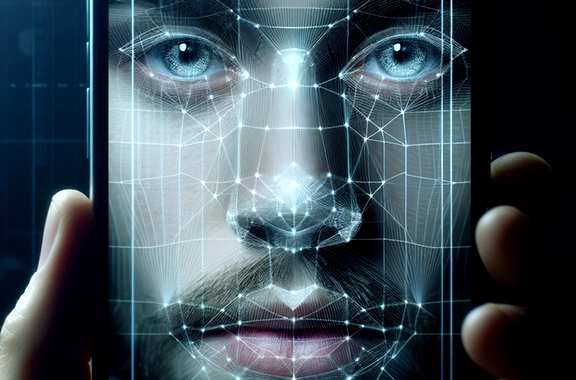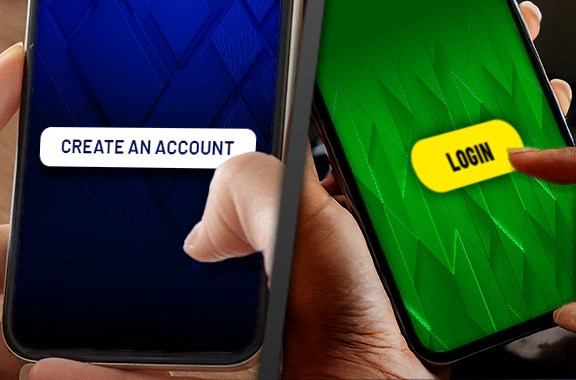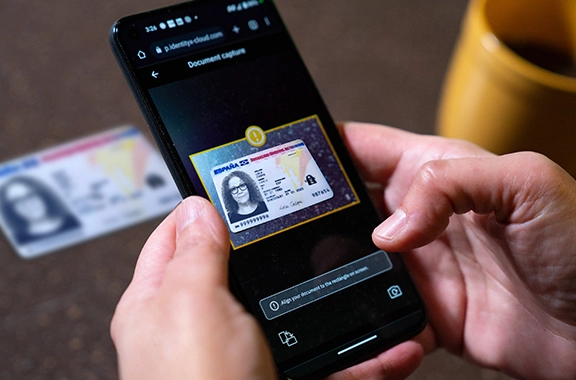Biometric Watchlists 101
On-server facial biometrics is the foundation of building secure watchlists, which can be used to create a powerful barrier against fraud and bad actors.
Watchlists use the benefits inherent in on-server facial biometrics to protect organizations against fraudsters and returning users attempting to spoof digital identity systems. This type of technology does more than just respond to attacks – watchlists adjust proactively to stay ahead of risks, ensuring that business’ online platforms remain safe and trustworthy.
On-server facial biometrics is characterized by facial recognition systems that process and store data on centralized servers, rather than individual devices (like Face ID, for example). Centralized management offers an efficient structure, allowing administrators to seamlessly manage, update, and maintain the biometric system. This is of particular importance for expansive organizations with vast user data, as the centralized nature ensures uniformity; every verification undergoes the same scrutiny, and software versions and configurations are applied across the board.
Using on-server facial biometrics to create watchlists means organizations can leverage the centralization, scalability, continuous development, integration capabilities, and historical data analysis native to on-server biometrics. These advantages offer businesses across industries a strong incentive to invest in watchlist security strategies.
How do watchlists work?
Watchlists have two main use cases. The most common is to prevent known fraudsters from accessing services or onboarding to an organization by requiring that every user first present their unique facial biometric.
Bad actors, whose arsenals of fraudulent technology are just as sophisticated as the digital identity security tactics available today to defend against them, often employ methods like deepfakes, synthetic identity, and social engineering to bypass an organization’s identity defenses. The latter is completely mitigated using on-server facial recognition, as no human interaction is required; with advanced, AI-powered PAD (Presentation Attack Detection) technology, spoofs like deepfakes and synthetic identities are a distant worry for modern businesses. Robus PAD checks run during the analysis of an on-server facial biometric examine a user’s face for liveness, image or video quality (lighting, detail, etc.), and up to hundreds of other data points – instantly – to determine that the face is in fact real and unaltered.
The second most common role of watchlists is to prevent users from accessing online services under different aliases but with the same face; in other words, to prevent a returning user (an individual person with a unique face biometric) from using multiple or different usernames/passwords and/or (a mixture of) other stolen credentials from creating accounts that bypass identity systems. Biometric watchlists eliminate this possibility, as a facial biometric is unique to each individual person and cannot be lost, stolen, or forgotten. Once registered on an identity ecosystem’s watchlist, each face biometric template will be recorded as belonging to a single entity, as the system would easily and instantly detect and reject any duplicate account attempts by a returning user.
Repeat customer watchlists help organizations keep their trusted customers and data safe. They also protect a business’ employees from being spoofed by returning users, eliminating any wasted time, energy, and costs used to address the account issues of disingenuous users.
Both types of biometric watchlists have wide applicability in a vast array of industries, especially for service providers who deal with high-risk transactions.
Watchlists across industries
In today’s digital-centric business landscape, ensuring the integrity and security of transactions is paramount. As cyber threats continue to evolve, so must the methods organizations use to counteract these risks. On-server biometric watchlists are a sophisticated, proactive solution tailored to address today’s challenge. Unlike traditional methods which can be compromised, facial biometrics offers an immutable, unique identifier: the human face.
Financial Services
Centralizing facial biometric template data on servers, as opposed to on local devices (like a customer’s smartphone), allows financial services organizations to leverage large datasets, enhancing accuracy and facilitating real-time updates. Biometric watchlists, which are comprised of flagged individuals or potential threat actors, serve as an early warning system for banks. When someone tries to open a new account or conduct a transaction, their facial data can be cross-referenced against the watchlist. If there’s a match, proactive steps can be taken to validate the individual’s intent, thereby thwarting potentially fraudulent activities before they transpire.
- Continual updates
- As fraudulent patterns evolve and new threats emerge, on-server systems can constantly update watchlists. This might include adding face templates from new fraud incidents or from shared databases of known fraudsters in the financial services industry.
- Cross-platform integrations
- Banks often operate multiple platforms and services. An on-server system ensures that a watch list can be deployed uniformly across all platforms, ensuring consistent protection.
- Improved due diligence
- When onboarding new customers, financial services organizations can cross-reference the provided facial biometrics against the watchlist, ensuring that individuals attempting to create accounts under aliases or stolen identities are promptly identified.
- Collaborative defense
- The centralized nature of on-server face biometrics can enable banks to collaborate and share watchlists (while respecting privacy regulations), creating a combined defense against fraudsters who might target multiple institutions.
The integration of on-server face biometrics with watchlists in the financial services sector not only deters known bad actors but also acts as a dynamic shield, evolving and adapting to the ever-changing landscape of financial fraud.
Esports and gaming
In the context of online gaming, a smurf refers to a player who intentionally plays at a level lower than their actual skill level – usually by creating a new account – to defeat less-experienced players. This behavior can be detrimental to the gaming experience for both newcomers and those playing at a genuinely lower skill level.
Utilizing a biometric watchlist powered by on-server facial biometrics can assist in preventing smurfing in esports.
- Identity verification
- By tying biometric facial data to individual player accounts, gaming platforms can ensure that the person accessing an account is the genuine owner. If a known high-ranking player tries to create a new account under a different name, their facial biometrics would flag the attempt.
- Historical gameplay analysis
- Once a player’s facial biometrics are stored and recognized, gaming platforms can analyze past gameplay patterns. If a player is consistently performing at a high skill level and suddenly starts a new account with beginner stats, the system would suspect smurfing.
- Dynamic game matching
- Players who are suspected of smurfing can be matched, by the gaming platform, with opponents of a higher skill level – even if their new account suggests they are beginners. This diminishes the appeal of smurfing, as these players won’t easily dominate in games.
- Penalties and bans
- If a player is repeatedly caught smurfing by a biometric watchlist, gaming platforms can impose penalties, including temporary or permanent bans. The risk of losing account privileges can be a strong deterrent against smurfing.
Online gaming platforms may drastically minimize the prevalence of smurfing by integrating on-server facial biometrics into a watchlist system, guaranteeing a fairer and more enjoyable gaming experience for all players.
Telecommunications
The telecom industry is no stranger to fraud. From unauthorized access to user accounts to fraudulent registrations for lucrative mobile contracts, the challenges are manifold. On-server face biometrics, combined with watchlists, emerges as a promising solution to curb these threats and ensure the security and integrity of services in the telco sector.
- Protection against unauthorized SIM swaps and account changes
- One common form of telco fraud is known as a SIM swap, where fraudsters attempt to take over a user’s phone number. This could lead to a plethora of problems, including intercepting sensitive messages or bypassing two-factor authentication methods on various online platforms. By employing on-server face biometrics, telco operators can ensure that any change or swap is verified against the watchlist of stored, genuine facial biometrics of account holders.
- Enhancing inter-carrier cooperation
- The telco industry often sees repeat offenders who make multiple attempts at unauthorized activities, either on the same network or across different ones. A centralized biometric system can maintain watchlists of these individuals, ensuring that if they attempt fraud once, their chances of succeeding in future attempts are significantly reduced.
- With appropriate permissions and respecting privacy regulations, telco operators can share watchlists of identified fraudsters. This collaborative approach means that if a fraudster is identified by one carrier, other carriers are immediately on alert, preventing the fraudster from simply jumping from one network to another.
The integration of on-server facial biometrics with watchlists represents a significant step forward in fraud prevention for the telecommunications industry, where quick, seamless, and secure services are paramount. Watchlists not only provide robust protection against current threats, but also equip telcos with the means to anticipate and combat emergent fraudulent techniques in the future.
Healthcare
In the healthcare industry, patient identification and clinician verification are paramount. Mistaken identities or unauthorized access to sensitive patient data can lead to serious medical errors, fraudulent activities, and violations of privacy laws. Here’s where a watchlist, powered by on-server facial biometrics, can become an invaluable tool.
- Patient identification
- Hospital systems often cater to thousands of patients. Ensuring the correct identity of each patient is crucial for proper treatment and care. Biometric watchlists can help quickly identify patients, especially in emergencies where the patient might be unconscious or unable to communicate. Such a system can ensure that medical history, allergies, and other critical information are correctly linked to the patient in question, preventing potential medical errors.
- Clinician verification
- Unauthorized access to patient data is a significant concern in healthcare. With biometrics-powered watchlists, providers can ensure that only authorized personnel, such as specific doctors, nurses, or technicians, access particular patient records. A clinician trying to access records outside their department or specialization, for instance, can be flagged by the watchlist, ensuring that patient data remains confidential and is only accessed on a need-to-know basis.
- Enhancing telehealth
- With the rise of telehealth, verifying the identity of both patients and providers has become even more critical. A watchlist can be used to ensure that any patient consulting a doctor online is indeed who they claim to be and that the clinician on the other end is a legitimate healthcare provider.
In healthcare, every change carries profound implications. The introduction of biometric watchlists serves as a potentially life-altering leap. Beyond just enhancing patient identification and clinician verification, watchlists guard the sanctity of medical data and patient safety.
Benefits of biometric watchlists
On-server biometric watchlists offer security, flexibility, and real-time analysis – all of which are critical to operating any successful, modern business endeavor in today’s digital age.
Centralized data management
One of the primary strengths of on-server systems is the centralized storage and management of data. This means that all facial template data, whether from new registrations or previous interactions, resides in a single repository. Such a central database can swiftly cross-check new entries against existing records. If an individual tries to register with a different name but has facial data already linked to another account or a flagged profile, the system can instantly detect the anomaly.
Scalability
On-server solutions are inherently scalable. As the database of users grows, so can the infrastructure, all without compromising on the speed or accuracy of facial recognition. This scalability ensures that even as thousands or millions of faces are added to the watchlist, the efficiency of the system remains intact, making it harder for malicious actors to slip through the cracks.
Continuous learning and improvement
Machine learning models, often deployed in advanced facial biometrics systems, thrive on data. The more data they receive, the better they become at recognition tasks. An on-server system that continuously encounters varied facial data can keep refining its algorithms, thus enhancing its accuracy over time. This ensures that even subtle variations or attempts to disguise one’s face can be caught.
Integration with other systems
On-server solutions can be seamlessly integrated with other security systems or databases. For instance, if there’s an external watchlist or a list of flagged individuals from other platforms or agencies, it can be integrated into the on-server biometric system. This holistic approach amplifies the security net and ensures that bad actors are flagged, irrespective of which platform or service they previously attempted to exploit.
Historical data analysis
With all data stored centrally, it’s possible to perform retrospective analyses. If an entity is flagged as suspicious, their past interactions or attempts can be traced, providing a comprehensive view of their activities. This can aid in investigations and in understanding patterns of behavior, which can further be used to enhance proactive security measures.
Looking ahead…
In the wide expanse of digital identity security, both users and business leaders find themselves on the edge of profound change. The cyber world we navigate is laden with both unprecedented opportunities and lurking threats. While on-device biometrics, including Face ID, has certainly carved a niche for itself and brought about a new age of conveniences and user-friendly interfaces, the profound resilience of on-server facial recognition cannot be overlooked. It is no longer just about choosing the best from the available options; it’s about forecasting and aligning with what our future security landscape demands.
For high-risk transaction industries, like finance and healthcare, the margin for error is razor thin. A data breach transcends the mere loss of information: it’s a potential whirlwind of financial pitfalls and tarnished reputations.
Authentication methods, then, are crucial pillars upon which our digital strategy rests. Leveraging on-server facial recognition and biometric watchlists can fortify any organization’s security measures against new and emerging fraud threats.






